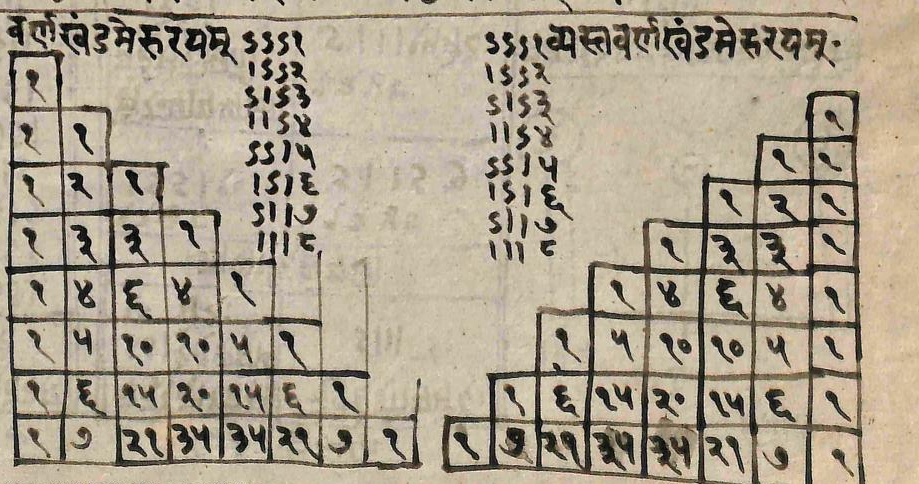Section 2.3 Binomial Coefficients
Objectives
- Prove the Binomial Theorem and apply it to find coefficients of terms in expansions.
- Describe and prove simple identities involving binomial coefficients possibly in relation to Pascal's Triangle.
Definition 2.3.1. Binomial Coefficient.
For
are called binomial coefficients.
Exploration 2.3.1. The Meru Prastaara (The Holy Mountain).

The Indian mathematician and writer Piṅgala (200 BC) in his text the Chandaḥśāstra studied variations in poetic metres when using only either long (g, for guru) and short (l, for laghu) syllables.
He explained that monosyllabic (or one-syllable) metres have two variations—either g or l—while disyllabic metres have four different kinds:
gg, gl, lg, or ll.
Or, one with no l's, two with one l, and one with two l's.
Piṅgala also observed that each two-syllable variant could be obtained from the one-syllable variants using the following scheme, appending on the right:
| monosyllabic | (g | l) | (g | l) | ||
| append | g | l | ||||
| disyllabic | gg | lg | gl | ll | ||
The same can be done going from two to three syllables.
| disyllabic | (gg | lg | gl | ll) | (gg | lg | gl | ll) | ||
| append | g | l | ||||||||
| trisyllabic | ggg | lgg | glg | llg | ggl | lgl | gll | lll | ||
(a)
Of the three trisyllabic variants with two l's (llg, lgl, and gll), one comes from the first group (ending with g), and two from the second (ending with l). Explain how this demonstrates that
(b)
Construct the table for the four-syllable forms in a similar way: appending g's to all trisyllabic forms, then appending l's. You should get a total of 16. In the same manner as (a), find an identity involving
by looking at the two possible endings of the four-syllable forms.
There are six strings involving g's and l's that have exactly two l's. How many of them end with g? How many with l?
(c)
Generalize the arguments above to a formula involving
Theorem 2.3.2. Pascal's Formula.
If
Checkpoint 2.3.4. Continue the Triangle.
Complete Pascal's Triangle up to the 9th row and use it to determine the value of \(\displaystyle\binom{9}{3}\text{.}\)
\(84.\)
Theorem 2.3.5. Binomial Theorem.
For
Proof.
Each factor in the product \((x+y)^n = (x+y)(x+y)\cdots(x+y)\) contributes either an \(x\) or a \(y\) in the resulting expansion. We can express each term in the answer as a sequence of \(n\) symbols, each either an \(x\) or a \(y\text{;}\) for example, picking \(x\) from each \((x+y)\) term gives \(\underbrace{xx\cdots x}_\text{$n$ times}=x^n\text{.}\)
Hence the number of times \(x^{n-k}y^k\) appears in the final expansion is precisely the number of rearrangements of the word
which is exactly equal to \(\frac{n!}{(n-k)!k!} = \binom{n}{k}\) by Proposition 2.2.10.
Checkpoint 2.3.6. Coefficient of
Determine the coefficient of \(x^4y^7\) in the product \((x+y)^{11}\text{.}\)
This is a direct application of Theorem 2.3.5.
\(\displaystyle\binom{11}{4}\) or \(\displaystyle\binom{11}{7}\text{.}\)
Checkpoint 2.3.7. Coefficient of
Determine the coefficient of \(a^2b^3\) in each product:
- \(\displaystyle (a+b)^5\)
- \(\displaystyle (a-b)^5\)
- \(\displaystyle (3a+2b)^5\)
b. and c. What are \(x\) and \(y\) in the statement of Theorem 2.3.5?
Checkpoint 2.3.8. Prove that
Prove that \(\displaystyle\sum_{k=0}^n \binom{n}{k} = 2^n\) for \(n \geq 0\text{.}\)
Stare at Theorem 2.3.5 until you see it.
Example 2.3.9. Lattice Paths.
On the \(xy\)-plane, a lattice path is a path that moves from integer point to integer point by taking only steps of length one to the right or upwards. For instance, the following are three different paths to the point \((4,2)\text{,}\) starting at the origin \((0,0)\text{:}\)
Each path above can be represented as a sequence of 4 R's and 2 U's:
RRUURR
UURRRR
RRRURU
so the total number of lattice paths from \((0,0)\) to \((4,2)\) is the same as the number of such sequences, which is
Checkpoint 2.3.10. Lattice Paths to
Count the number of lattice paths ending at \((a,b)\) for integer \(a,b \geq 0\text{.}\)
\(\displaystyle\binom{a+b}{a}\) or \(\displaystyle\binom{a+b}{b}\)
Checkpoint 2.3.11. Lattice Paths, specific numbers.
Determine the number of lattice paths that end at:
- \(\displaystyle (5,4)\)
- \(\displaystyle (4,4)\)
- \(\displaystyle (5,3)\)
Simplify your answers to arrive at a single number for each part. How are your answers related?
(a) \(=\) (b) \(+\) (c).
Checkpoint 2.3.12. Lattice Paths and Pascal's Formula.
Prove Theorem 2.3.2 using lattice paths and an idea from Checkpoint 2.3.11.
Count the number of lattice paths to \((k,n-k)\text{.}\)